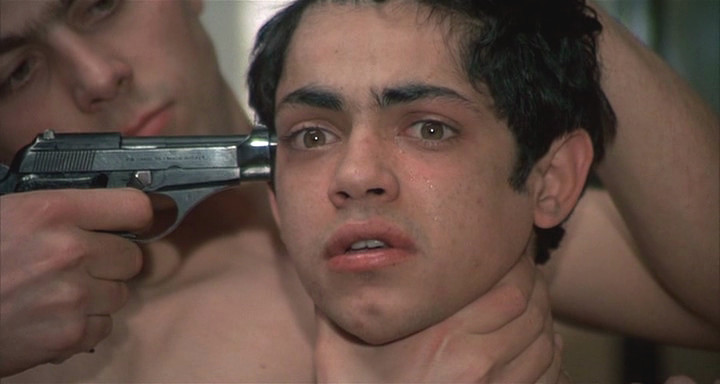
A quick glance at IMDb’s Top 250 page, or even at nominally more serious attempts to supposedly list the “greatest films ever,” shows that few people, their claims of be-ing “cinephiles” notwithstanding, take cinema seriously as an art form.
The petit bourgeois journalist-cum-“critic” views cinema the same way he (it is usually a he) views a late-afternoon newspaper crossword or Sudoku puzzle, namely, as a decoder-ring semiotic symbolization to be deconstructed, by “reading” visu-al/formalistic and stylistic virtuosity or assigning meaning to easily-decoded predeter-mined camera movements.
He views the “greatest films ever” as being so great pre-cisely because every moment in them – every shot, every camera movement or position, every editing technique and decision, etc. – is intentionally and specifically endowed with an obviously- and easily-decodable “meaning” even the most unsophisticated viewer can understand within a few seconds.
So, for example, a large and empty house – especially if filmed from within a corridor – signifies a character is either lone-ly or depressed (and, naturally, so must the viewer feel after decoding said meaning), a lightning storm that the characters experienced an emotional turmoil, a husband and wife sitting at the opposite ends of a massive dinner table that their marriage is in shambles, and so forth.
These films do not engage with emotions or have viewers work out their emotional responses to depicted situations step-by-step perceptually and perceptively, rather, they explicitly tell the viewers when to feel sad or happy and, rather than having them work with the characters’s emotional, physical, or vocal/verbal states, simply tell the viewers immediately how they feel.
Dialogue, acting, characteri-zations, human interactions, etc., are minimal and functional at best, and frowned up-on at worst, in these “greatest films ever,” interfering with the journalist’s definition of great cinema as one that “tells a story and a plot using visual and cinematic devices.”
And, if these “greatest films ever” have some generic and simplistic formulaic and/or abstract take-home message, especially if conveyed through these easily-decodable “hidden and deep meanings” – virtually always either some basically-true yet painful-ly-obvious-without-seeing-the-film and banal cliché or stereotype taken for granted by practically every semi-educated adult (e.g. “racism and war are bad,” “money is not everything and our current economic system is not perfect either,” “different people have different opinions,” “it is a bad and even dangerous idea to allow governments and corporations to develop technologies that shall allow them to spy on civilians, that may even cause alienation,” “there are several differences between the Jewish and Christian views of morality,” “society tends to be dominated by men,” “American so-ciety tends to value X or Y and that is not optimal,” “politicians and journalists some-times lie,” etc.), a crude and rather abstract popularization of some philosopher’s or theoretician’s views with little to no relevance to actual life and lived experience, triv-ial informative tidbits derivative of ideas more fully expressed elsewhere where the sole purpose of cinema is not to present anything new but merely to use said “cinemat-ic language” to express them (e.g. the director’s views regarding the Vietnam War or the Gulf War, metaphorical retellings of the stories found in the Book of Genesis or the New Testament, “this-means-that” metaphors where one easily “gets” the direc-tor’s intention of pointing our attention at some historical event, etc.), or, pandering to the politically-correct ideology of the bourgeoisie endlessly regurgitated by the media (yet still presented as subversive despite being hegemonic) by telling it what it wishes to hear regarding, for example, victimhood – the journalist likes them even more and he will even claim they are “deep.”
What is clear is that emotionally-profound learning, truth-based experiences, and actor-focused character interactions based on the human body intended to provide the viewers with an understanding of and ways to improve themselves, their selves, and their lives are the last things on these people’s minds. These are referred to by this coterie as “merely filmed theatre or literature,” just about the worst offence in their eyes.
Easy and easily-understandable Platonic grand themes and ideas as well as shortcuts to emotional understandings of characters and self, en-gendered by intellectually codifying camera angles within two seconds and other such easily-decodable devices situated outside the human body, in which life is framed and nothing is its brute self but a symbol, easily take the cake over emotional profundity for these folks.
Films dealing with difficult emotional situations and with the com-plexities of life by focusing on the body and acting, in which the camera is merely functional, are “non-cinematic” and hence more-or-less the enemy.
The testosterone-fueled dudebro psychology underlying much of this “canon,” the obsession with, not to say fetishizing of, technological tricks and lack of interest in emotional and psychological complexity, as can be ascertained just by looking at the top fifty or so films at IMDb’s Top 250 page or the endless columns claiming that tel-evision series glorifying the mucho thuggery of mobsters and their explosions and car chases (“quality dramas”) are somehow equal to the greatest works of Western civili-zation (not to mention beer commercials!), should be clear.
In my country, the most popular website dealing with cinema seems to operate out of some ressentiment allow-ing its visitors to eat their cake while keeping it too, namely, to be interested in little more than emotionally-stale flicks centered on simplistic messages and easily-decodable decoder-ring symbolizations, all filled with all the explosions and car chas-es and button-pushing fight-or-flight reptilian comic-book thriller plots and “cool” stylizations teenage boys like, while still winning cultural and symbolic capital by claiming nobody can define what art is and that all cultural values are subjective and arbitrary, indeed, the very existence of art, independent, and experimental/avant-garde cinema often causes these people extreme anxiety for these very reasons.
“There’s also a gender component to it [and] [i]t’s no accident that most of these critics – and the filmmakers they adore – are men [because] [i]t’s a boy thing [and a] teenage boy thing. ‘[l]ook at how tough I am [and] [h]ow unsentimental I can be. I’m a real guy,’” wrote critic Ray Carney. “Films which plug”, he wrote elsewhere, “into boy fantasies of dis-covering secrets about the adult world and enacting a cosmic destiny [in which] [e]very button in the adolescent male psyche is pushed—from the fascination with gadgets (computers and cell phones), to the feeling that no one understands you, to a sense of nostalgia for a lost youth [in which] every boy-in-a-baseball-cap can revel in his fantasy of rebelling against authority and saving the world, obtaining the love of an older and wiser woman (so there will be no messy sexual complications, like having actually to talk to her), and being a ninja-samurai warrior-Zen master […] at the same time [in which] [t]wenty-somethings undergoing a crisis about becoming middle-class wage slaves can indulge their fantasy of being closet-rebels with deep philosophies,” merely collapse “into an adolescent wail of despair or trying to recapture a golden age of childhood that never existed in the first place [which] is just another form of escap-ism, another way of avoiding and denying the claims and complexities of adult life, another way of refusing to grow up […] young people in these films and the young people watching them wash their hands of the problems of adult society and console themselves that they are the hapless victims of even more screwed-up parents [so] [t]hey can blame their father, mother, or other authority figure for their problems [and] [i]t’s flattering because it allows young viewers […] to cast themselves as and to iden-tify with all of the other damaged, weak, heartbroken misfits [hence] [i]n a word, it allows the viewer […] to feel sorry for himself: ‘[o]h, it’s so hard to be born into a world where there are no more heroes, where everyone is flawed, where eternal love is no longer possible. I’m so lonely I could cry [and] [w]oe is me [b]ut it’s comforting to know I’m not the only one who feels this way.’”
No wonder most films considered the “greatest ever” or the most “philosophically” (i.e. being based on easily-decodable tidbits pandering to adolescent boys) “profound” could be summarized as “nobody understands you and adult society is just a bunch of dirty secrets, so be a real man, rebel against authority, and blow something up.”
This list/article is the first in a series trying to take a different approach by moving beyond the “greatest films ever.” Could actor-based performances, as a form of truth-telling, enrich our lives much more and in much more complex ways than the standard Hollywood-filmmaking of assigning meaning to easily-decoded predeter-mined camera movements and other such shortcuts to understanding? Could films taking this approach teach us anything new that is not trivial, move us past received opinions and social dogmas, and force us to look at that we have forgotten?
Of course, it is possible to try to clumsily coerce art, experimental/avant-garde, and independent cinema into the aforementioned standard modes of understanding, though, by doing so, one will never understand what makes them different from Hollywood fare.
To-day we shall try to answer this question, by paying attention only to body-, dialogue-, and acting-focused cinema and ways of knowing and by ignoring all “purely cinemat-ic language” approaches, by looking at films often described as infamous, politically-incorrect, shocking, offensive, gross, or disturbing.[1]
1-3. Marian Dora Botulino’s Melancholie der Engel (2009), Reise nach Agatis (2010), and Debris documentar (2012)

With lewd abandon consisting of not just mostly unsimulated sex but also coprophagia, urolagnia, torture, klismaphilia, animal abuse, church-desecration, and bestiality/necro-zoophilia, this little-known trilogy (with merely 639, 174, and 65 rankings currently listed, respectively, on IMDb, at the time of the writing of this list), while notorious for all the wrong reasons among con-noisseurs of extreme cinema who regularly place it at the top of their most-disturbing-ever lists – with content so controversial it forced its director into using a pseudonym and never revealing his face for fear of legal action and other security issues – what is rarely mentioned is that it is not just one of the most extreme occurrences in the histo-ry of cinema graphically-wise but also emotional depth-wise.
Anticipating (not just in its name and sources of inspiration, more on that soon) Lars von Trier’s highly viscer-ally-profound and stomach-turning depiction-nay-outright-bestowing-of-an-experience-upon-the-viewer of depression Melancholia by two years and akin to a painting by Albrecht Dürer, Jackson Pollock, Paul Klee, or Käthe Kollwitz in its pow-erful emotional impact, this is probably the most direct confrontation with depression, loss, suffering, death, bereavement, and grief ever put not just to screen and one of the rawest collection of emotional moments available everywhere, with many of the comparatively few people who watched it reported on various internet websites that it saved them from their own suffering and depression.
A religious and spiritual expres-sionistic-gothic-romantic-modernist depiction – with the understanding that a film not having a “plot” being a plus rather than a valid “criticism” due to it shifting the focus from reptilian “twists” to human interactions, the epiphany that films in which “noth-ing happens” are the ones in which everything that matters happens and that no car chase has ever been as dramatic as a “cinematic language”-free theatrical-like life-changing presentation of several people merely speaking in a room with the viewer left to follow their tonal and bodily shifts and turns has never been clearer than in this tril-ogy – based entirely on highly expressionistic and corporal acting and highly profound, developed, and, with the understanding that art is defined by its ability to make one understand oneself and experience deep and sincere emotions one has never encoun-tered before, especially upon encountering the radical alterity which is one’s self, in-teresting characters, we follow a group of broken outsiders destroying their selves, their bodies, and the nature surrounding them with the intention of attaining divinity and integrating with the cosmos through cleansing their sins by bringing their very soul and consciousness to a degree of angelhood.
This life-changing cinematic poem with no “message” or “bottom-line” except for the experience of living life and love (and not primarily in the sexual or romantic meaning) on steroids it provides, almost all of whose dialogue is taken from the verses of the likes of Rainer Maria Rilke, Johann Wolfgang von Goethe, Johann Sebastian Bach, Thomas Mann, Georg Büchner, Frie-drich Nietzsche, the Marquis de Sade, Lord Byron, Wolfgang Köppen, John Dowland, Rainer Werner Fassbinder, and Eduard Mörike, will feel as if created only for them and only with them in mind by all viewers who ever felt outside the social dogma.
Es war ihm dann, als existiere er allein, als bestünde die Welt nur in seiner Einbildung, als sei nichts, als er, er sei das ewig Verdammte, der Satan; allein mit seinen folternden Vorstellungen. (Karl Georg Büchner, Lenz, 1836)
4. Thierry Zéno’s Vase de noces (1974)

Still banned for all the wrong rea-sons in many countries (e.g. Australia), this little-known (a mere 1,108 votes on IMDb) Belgian experimental silent, akin to an Aktion by Hermann Nitsch or Günter Brus and just as emotionally-intense, depicting a sole actor fornicating with a sow and consum-ing its and his feces and urine, is known, if known at all, largely for its shock value.
It was intended, however, according to its recently-deceased (with barely any media coverage) director, as with the previous entry on this list, as an expressionistic reflec-tion, that is to say an attempt to provide the viewer this experience expressively, on the inherent self-destructive nature of depression and suffering and of man’s will to escape this finite mortality, and to this day, remains one the most powerful attempts to do so ever caught on celluloid: “[t]he principle idea behind all of the sequences in Vase de noces is death [so] [t]he film is about an alchemist who is attempting to find the secret of immortality [who] is not trying to change material into gold but trying to change death into life [and] [t]his is why he is more preoccupied with the ‘signs’ of his death that he wishes to transform into ‘signs’ of life [hence] [w]hen he is shown play-ing with his shit it is not simply provocative; it represents the idea of the metaphysical.”
5. Pier Paolo Pasolini’s Salò o le 120 giornate di Sodoma (1975)

Critic Gary Indiana wrote that this film is most preoccupied by the idea that “[r]epressive tolerance has returned much of the gay world […] to the voiceless, irrelevant patholo-gy of the period before gay liberation, with the difference being that today’s gay can celebrate that pathology (fascistic worship of perfect bodies, contempt for the sexually superannuated, libidinal narcissism) with the same fearlessness that normal people cel-ebrate their worship of money and consumer goods, without the intrusion of human-istic ethics or any sense of social justice” and “anything short of murder between con-senting adults, in some circles, might be experienced with […] the public visibility of ‘extreme sexuality’ [is a] ‘lifestyle’ as a fashion choice [which became] chic.”[2]
Much more famous than most films on this list as an artifact of exceedingly disturbing cine-ma, this transport of the Marquis de Sade’s depictions of coprphilia, sadism, urophilia, pedophilia, and necrophilia into fascist Italy, replete with references to Marcel Proust, Dante Alighieri, Carl Orff, Ezra Pound, Charles Baudelaire, Simone de Beauvoir, Pierre Klossowski, Roland Barthes, Philippe Sollers, and Maurice Blanchot, remains the most poignant and salient critique of the soft totalitarianism and bourgeois middle-class vice of celebrating destructive pathologies in the name of “open-minded ac-ceptance” and “tolerance,” sexual and non-sexual alike, in the cinematic canon and is as unfashionable, outside the boundaries of accepted opinion and received moral sen-sibilities amongst the chattering classes, and politically-incorrect as ever, in simple words a real subversive speaking of truth to power and assault on the powers that be rather than an affirmation of bien-pensant and Gutmensch hegemonic sensibilities masquerading as such, foreshadowing works in other media by such luminaries as Robert Mapplethorpe or Samuel R. Delany with as much brutal honesty and candor.
Pasolini never attended film school and his lack of “cinematic gaze” i.e. the privileging of codifying camera movements instantly digestible as substitute for emotional sinceri-ty over human interactions is showing, all for the best (content-less and sterile tech-nique-fetishizing “auteur theory was akin to celebrating the designer of a line of stoves or refrigerators,” comments Indiana).